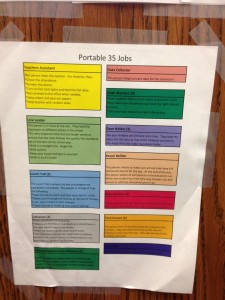Where has the time gone?
I think it’s about time to create a post for the current status of our class. We’ve covered quite a bit in the last few weeks of school. September seems like yesterday. Well, let’s take a look back to review some of the learning.
In the beginning of our school year we took quite a bit of time learning about our classroom. This involves learning school policies, classroom processes, classmate names, etc… Families really got swamped with information. Hopefully, this was as stress free as it could have been. Here are some of the key components of our community:
- The Classroom Purpose
- The Code of Cooperation
- Classroom Jobs
The Classroom Purpose is really essential to all we do. We visit it weekly. The kids came together in the month of September and determined what we wanted for our purpose. It all started with “Why did you come to school today?” That simple question lead to the purpose you may have seen in newsletters, at the top of our blog site and above our classroom door. See if your child can recite it for you.
The Code of Cooperation is another artifact that kids came up with to help build our classroom community. They made suggestions for it and were responsible for documenting. Again, we visit this often. Your child may have already discussed it with you. If not, ask them how it helps them to learn.
Sometimes the classroom operates a little bit chaotically if we don’t have people in charge of things like organizing the classroom library. It just gets forgotten. So, we’ve developed a team of people that have added responsiblities for helping out in the portable. Again, this was student driven in terms of what the final picture looks like for our jobs team.
The more traditional learning that we’re all familiar with is ongoing in our little portable space. So far, students have spent quite a bit of time reviewing old concepts from previous school years. For instance, in math we’ve examined place value, adding and subtraction of multi-digit whole numbers and adding and subtracting of decimal numbers. So, what might be new? We’ve looked at converting numbers from decimals to fractions and fractions to decimals. Kids have learned to write decimal numbers in word form. Also, we’ve stretched numbers out to be in expanded form versus standard form.
In science, it’s all been new. The focus was on environments, but more specifically on controlled experiments. For instance, we discovered what caused acid in our fresh water aquariums. Our class also learned about a special salt water environment, Mono Lake, and ran an experiment with sea monkeys, or brine shrimp. See if your child can describe the typical controlled experiment. The video below may help remind them. Also, extend this learning by asking them to review the brine shrimp experiment with you.
Wow, that was a lot of information. I could review more, but I think it would be good to cover what’s current. Maybe your thinking, “What can we do at home to support learning in the classroom?”
- Math-Have your child practice multi-digit multiplication with whole numbers.
- Reading-Ask your child to read independently 20-30 minutes each night and follow up with them by having them write down a prediction for the upcoming chapters. Ask them to share the story information that makes them think this prediction will come true.
- Science-Our next science unit will cover variables. Kids in our class need to be able to identify controlled variables, manipulated variables and responding variables.
In the future, most of our classroom posts will be shorter. I’ll try to make them occur more regualarly throughout the school year. I hope this will help you to understand what’s going on in Room 35. Also, I hope it keeps you coming back for more information and begin to help create a relevant dialogue between you and your child related to learning.






